Federated learning in hearing health apps allows you to benefit from personalized sound processing and device improvements without sharing your sensitive data. It keeps your information on your device while models learn from multiple users through encrypted updates. This approach enhances privacy and security, ensuring compliance with regulations like HIPAA and GDPR. If you stay engaged, you’ll discover how these innovative techniques continue to evolve and protect your hearing health.
Key Takeaways
- Federated learning enables decentralized model training on hearing aid devices, improving algorithms without sharing raw user data.
- Privacy-preserving techniques like data encryption and local data processing protect sensitive hearing health information.
- Model updates are aggregated securely, maintaining user confidentiality while enhancing sound quality and device connectivity.
- Strict user consent and compliance with regulations like HIPAA and GDPR ensure transparent and trustworthy data handling.
- These approaches foster user trust, promote adoption of personalized hearing solutions, and address privacy challenges in hearing health apps.
Understanding Federated Learning in Hearing Health
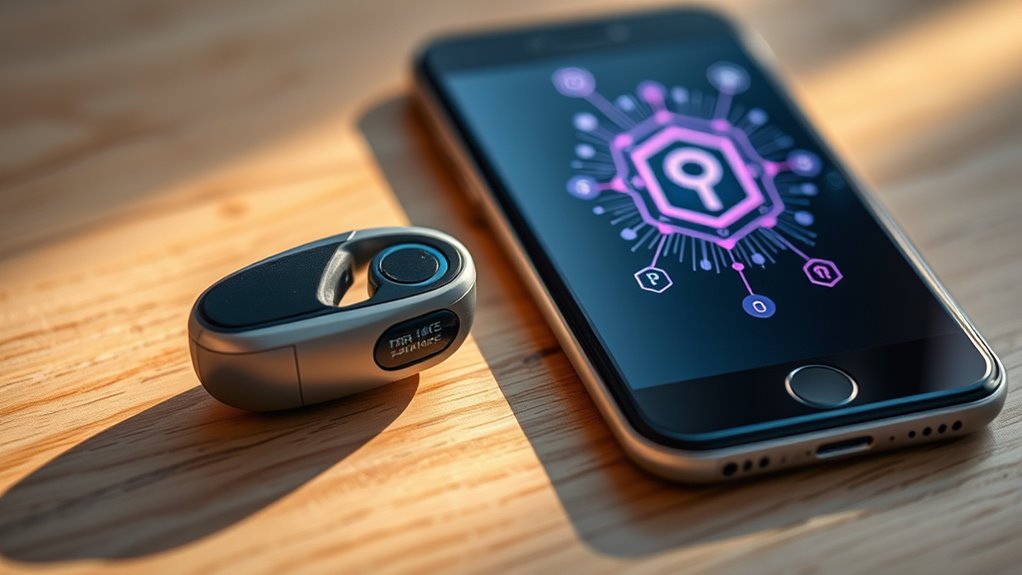
Federated learning is a decentralized approach that allows hearing health apps to improve their algorithms without sharing sensitive user data. Instead of transmitting raw data, your device processes information locally and only shares model updates, which enhances sound quality and device connectivity. This method helps optimize how your hearing aids adapt to different environments, ensuring clearer sound and better performance. Additionally, this approach aligns with privacy preservation strategies emphasized in well-being tips, safeguarding user information while improving functionality. As your device learns from your usage, it can fine-tune its settings without risking your privacy. You’ll notice improved sound clarity and more seamless connectivity with other devices, all while keeping your personal data secure. Federated learning empowers your hearing health app to become smarter and more personalized, without compromising sensitive information. It’s a game-changer for privacy and performance in hearing technology.
The Privacy Challenges of Hearing Health Data
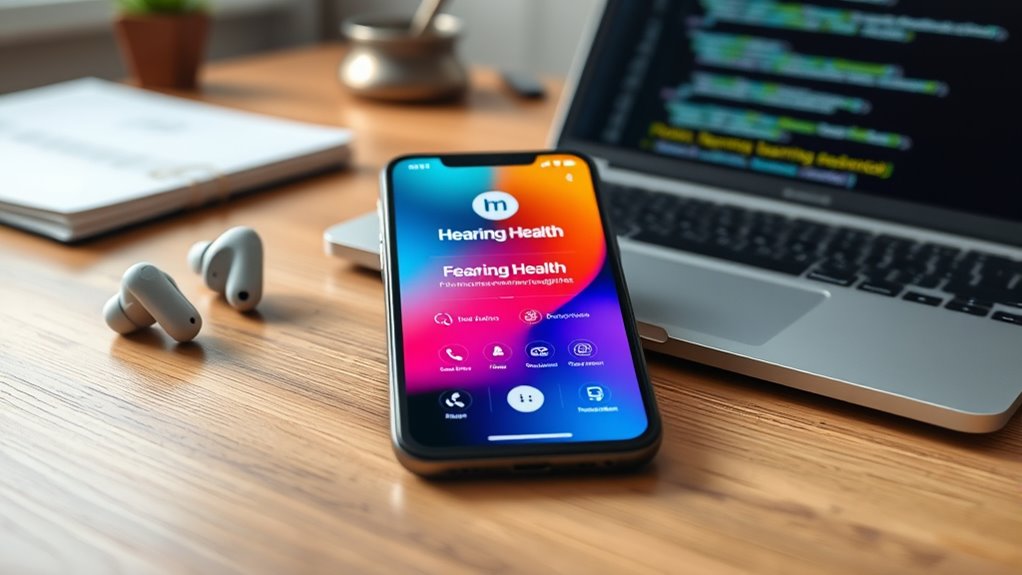
Your hearing health data is highly sensitive, making privacy a top concern. Unauthorized sharing or access could lead to serious consequences, including identity theft or misuse. Addressing these challenges is essential to protect your personal information and build trust in hearing health apps. Implementing secure data protocols can help safeguard sensitive information from potential breaches.
Data Sensitivity Concerns
Hearing health data is highly sensitive because it often reveals personal information about your health status, lifestyle, and daily routines. This sensitivity raises concerns about privacy and data misuse. You might want personalized recommendations, but sharing raw data can expose you to risks. Data anonymization helps protect your identity, but it’s not foolproof. To emphasize, consider this table:
| Data Type | Privacy Risk | Mitigation Strategy |
|---|---|---|
| Listening habits | Re-identification from patterns | Data anonymization |
| Health metrics | Unauthorized access | Encryption |
| Device usage | Identifiable behavior | Limited data sharing |
| Personal info | Data leaks | Strict access controls |
While federated learning reduces risks, understanding data sensitivity remains vital to safeguarding your privacy.
Unauthorized Data Sharing
Unauthorized data sharing poses significant privacy challenges because sensitive hearing health information can be exploited if it falls into the wrong hands. Data breaches can occur when third parties access or distribute your data without permission, risking your privacy. Without proper consent management, users might unknowingly share personal hearing data, increasing vulnerability to misuse. Hearing health apps must implement strict controls to prevent unauthorized sharing, such as encryption and access restrictions. Clear, ongoing consent processes empower you to control who sees your data and when. Addressing these challenges requires robust privacy policies and transparency, ensuring your data isn’t shared or sold without your explicit approval. Protecting hearing health data safeguards your privacy and maintains your trust in these digital health solutions. Additionally, implementing security protocols is crucial for maintaining the confidentiality of sensitive information.
How Federated Learning Preserves User Confidentiality
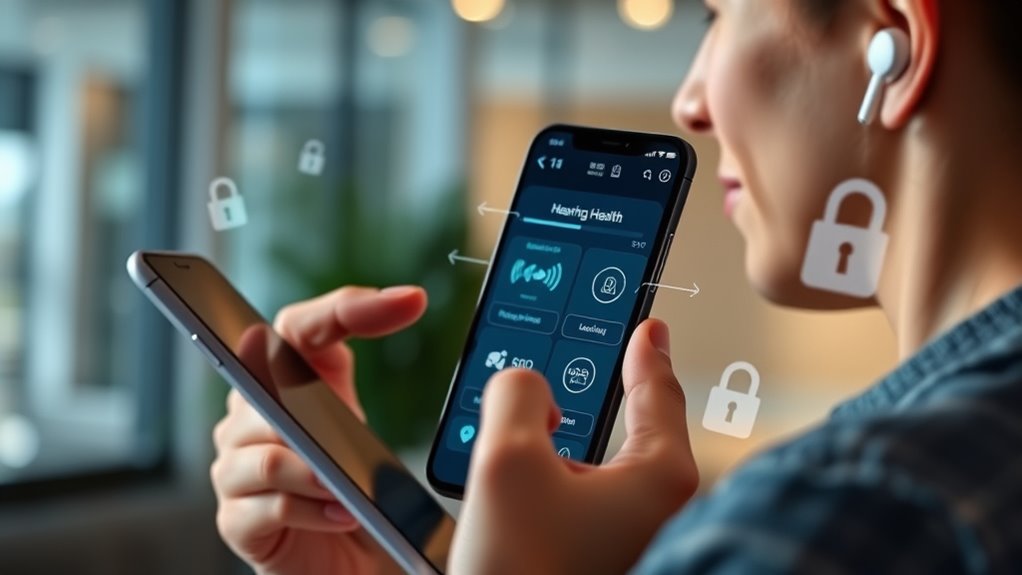
Federated learning enhances user confidentiality by keeping sensitive data on individual devices rather than transmitting it to centralized servers. This approach minimizes the risk of data breaches and unauthorized access. To further protect your information, models use data encryption during the sharing process, ensuring that the data remains unreadable to outsiders. Additionally, federated learning promotes user anonymity by aggregating updates without revealing personal details, making it impossible to trace data back to you. This method ensures that your specific hearing health data stays private, even as insights are shared to improve the overall system. For example, Cultural and Regional Breakfasts illustrate how diverse data types can be integrated securely without compromising individual privacy. By combining data encryption and user anonymity, federated learning offers a robust way to preserve your confidentiality in hearing health apps.
Technical Foundations of Federated Learning
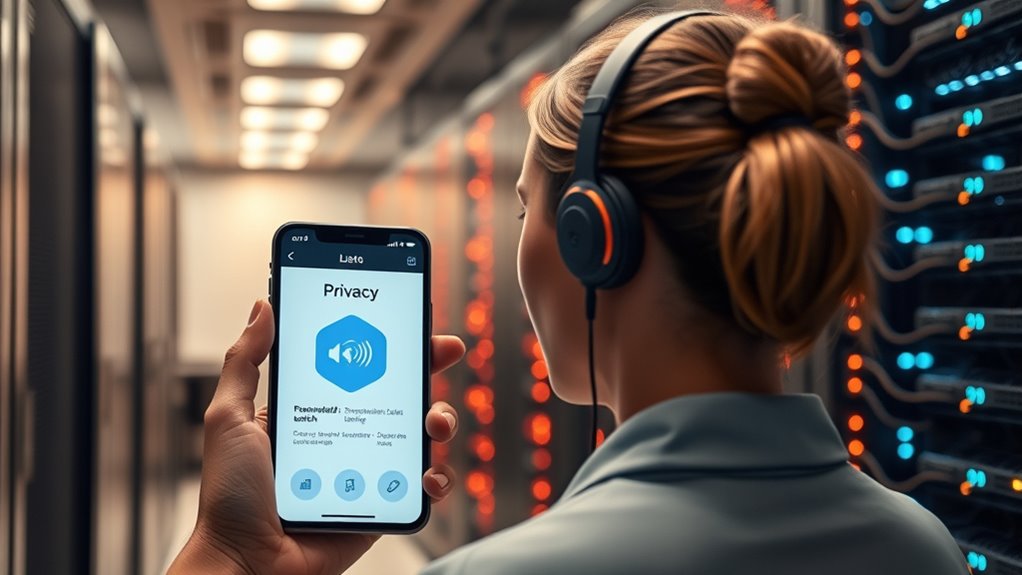
At its core, federated learning is a decentralized machine learning approach that trains models directly on users’ devices, rather than relying on a central server to collect all data. You can imagine it as a process where:
Federated learning trains models directly on user devices, ensuring privacy without sacrificing accuracy.
- Each device computes its local updates, like adjusting a puzzle piece to fit perfectly.
- These updates, or gradients, are then sent for aggregation without exposing individual data.
- The server combines these gradient updates, working toward model convergence across all devices.
This method guarantees privacy while maintaining accuracy. The key is efficient gradient aggregation, which synchronizes learning progress without compromising data confidentiality. As a result, the model gradually converges, learning from diverse, decentralized data sources while preserving user privacy.
Additionally, techniques such as contrast ratio optimization further enhance model robustness by improving how visual data is processed during training.
Implementing Federated Models in Hearing Applications
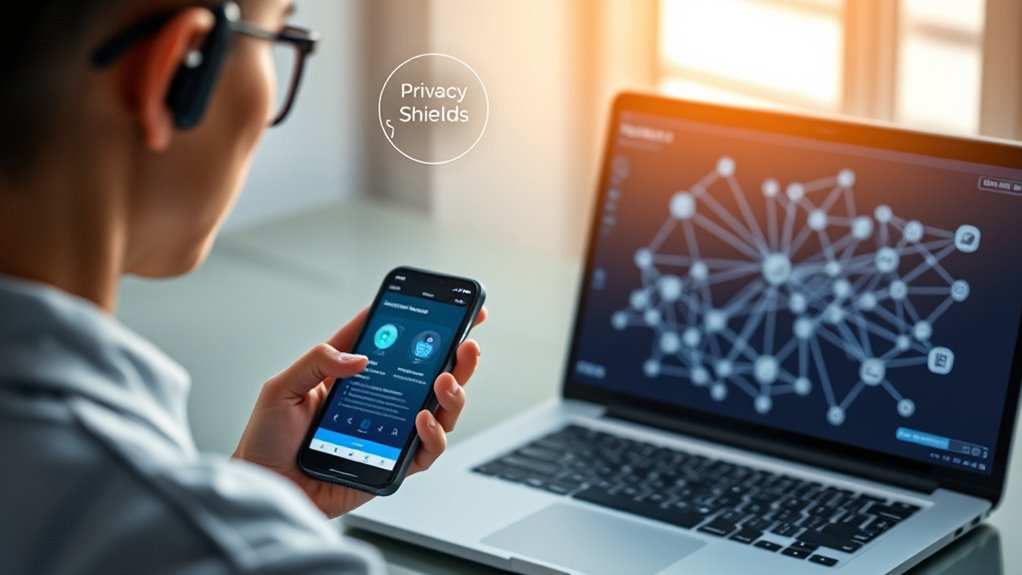
Implementing federated models in hearing applications involves deploying algorithms directly onto your devices, like hearing aids or smartphones, to enhance auditory perception without sending sensitive data elsewhere. This approach allows personalized device calibration based on your unique hearing profile while maintaining privacy. You can imagine how the process works:
| Device Type | Data Processed | Personalization Focus |
|---|---|---|
| Hearing aids | Local sound data | Adjusting for environments |
| Smartphones | User feedback | Fine-tuning sound clarity |
| Wearables | Ambient noise | Noise suppression |
| Tablets | Listening preferences | Custom sound profiles |
| PCs | Speech patterns | Improving speech recognition |
This setup ensures your hearing device adapts to your environment efficiently while safeguarding your auditory perception data. Incorporating industry trends helps optimize the deployment of these models effectively.
Benefits of Privacy-Preserving Machine Learning

Privacy-preserving machine learning enhances data security by keeping sensitive information local, reducing the risk of breaches. It also helps build user trust, as people feel more confident sharing data when their privacy is safeguarded. Additionally, it ensures your app stays compliant with regulations, avoiding potential legal issues.
Enhanced Data Security
Privacy-preserving machine learning enhances data security by ensuring that sensitive hearing health data stays protected throughout the process. It does this by implementing strong measures such as:
- Data encryption, which scrambles your information so it’s unreadable if intercepted.
- Strict user consent, ensuring you’re in control of what data gets shared and when.
- Local processing, where data remains on your device, reducing exposure risks.
- Incorporating AI algorithms that analyze data without exposing individual details during processing.
These methods keep your information safe from breaches and unauthorized access. By encrypting data, even if it’s intercepted, it remains unintelligible. User consent guarantees you’re aware of and agree to data use. Overall, these strategies provide robust security, minimizing risks and safeguarding your hearing health data at every step.
User Trust Building
When your hearing health app uses privacy-preserving machine learning, it builds trust by showing you that your personal data is protected at every step. This transparency encourages greater user engagement because you feel confident your sensitive information isn’t at risk. As trust grows, you’re more likely to stick with the app and share accurate data, which improves its effectiveness. Privacy-focused technology reassures users, making them more comfortable with adopting new features and updates. When users see that their privacy is a priority, they’re more inclined to recommend the app to others. Additionally, understanding data security practices can further enhance user confidence. Ultimately, this positive perception of data security enhances overall technology adoption, creating a cycle of increased trust, better user experience, and more widespread use of hearing health solutions.
Regulatory Compliance
Implementing privacy-preserving machine learning in your hearing health app helps guarantee you stay compliant with evolving regulations like HIPAA, GDPR, and other data protection laws. This approach aligns with regulatory frameworks and adherence to compliance standards, reducing legal risks. Imagine:
- Securing sensitive user data so it remains confidential and protected.
- Maintaining audit trails that demonstrate your app’s compliance efforts.
- Building trust by transparently handling user information in line with legal requirements.
Furthermore, adopting a holistic digital parenting approach ensures that your app not only complies legally but also promotes overall child well-being beyond just technology management.
Potential Limitations and Challenges

Despite its advantages, federated learning faces several significant limitations and challenges in hearing health apps. Scalability issues arise as the number of users grows, making it harder to coordinate updates efficiently without overloading devices or networks. Additionally, the models used for hearing health often become complex, requiring substantial computational resources that may not be available on all user devices. This complexity can lead to longer training times and reduced real-time performance. Furthermore, managing diverse data across various devices increases the risk of inconsistent model updates, potentially impacting accuracy. These challenges highlight that, while federated learning offers privacy benefits, implementing it effectively in hearing health apps demands careful attention to system scalability and model optimization to ensure reliable, efficient performance. Moreover, local store hours may influence the timing of app updates and maintenance activities, which can be critical for continuous service.
Future Directions for Secure Hearing Health Technologies
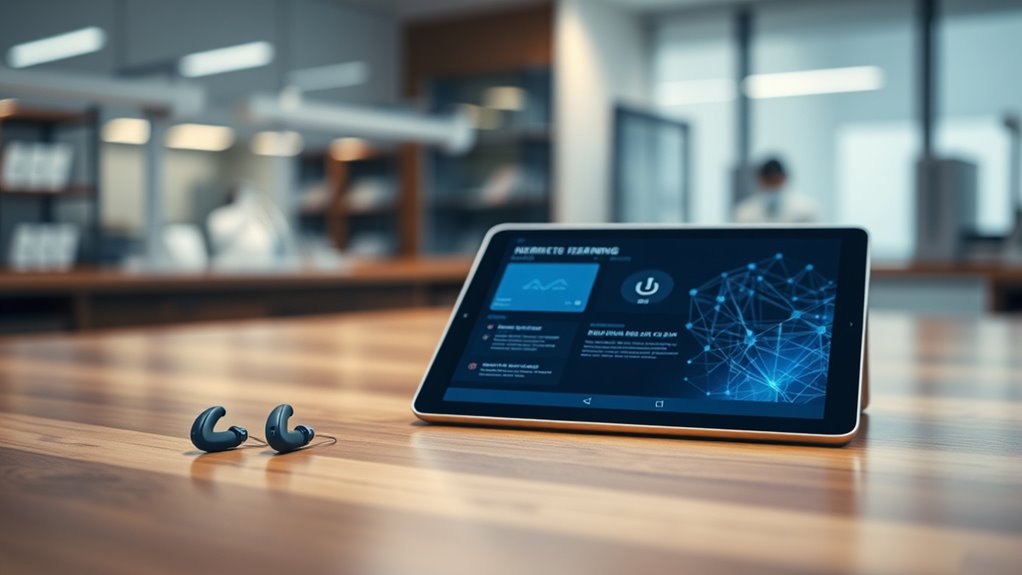
Looking ahead, the future of secure hearing health technologies hinges on advancing privacy-preserving methods and integrating cutting-edge security measures. You’ll see innovations such as:
- Leveraging auditory neuroscience insights to develop smarter, context-aware hearing aid technology that adapts seamlessly without risking data leaks.
- Implementing encryption techniques that protect sensitive auditory data during processing and transmission.
- Employing federated learning to improve device intelligence while keeping user data local, reducing exposure. These advancements will enable more personalized, secure hearing solutions. By focusing on privacy, you can trust that your hearing health data remains confidential. As technology evolves, these strategies will foster safer, more effective hearing health tools that respect your privacy while enhancing auditory performance.
Case Studies and Real-World Applications

Have you ever wondered how privacy-preserving techniques are applied in real-world hearing health devices? Many use federated learning to improve voice recognition without sharing sensitive data. These devices often need to communicate seamlessly, highlighting the importance of device interoperability. For example, hearing aids now collaborate with smartphones and smart home systems, enhancing user experiences while maintaining privacy.
| Application Area | Technique Used | Benefit |
|---|---|---|
| Voice Recognition | Federated learning | Improved accuracy, privacy |
| Device Interoperability | Local model updates | Seamless integration, security |
| Data Security | End-to-end encryption | Protects sensitive info |
| Real-World Devices | Cross-platform compatibility | Broader accessibility |
Frequently Asked Questions
How Does Federated Learning Impact Hearing Aid Device Battery Life?
You might wonder how hearing aid battery life is affected by technology. Implementing advanced features can increase power consumption, reducing battery life if not optimized. However, with effective battery optimization techniques, power consumption stays in check, helping your device last longer. While some processes might use more energy, smart power management guarantees your hearing aid remains efficient, balancing performance with battery life for your convenience.
Can Federated Learning Be Integrated With Existing Hearing Health App Platforms?
You can integrate federated learning with existing hearing health app platforms, but it depends on device compatibility and your user engagement strategies. Ensuring the devices support the necessary data processing is key, and keeping users engaged helps gather meaningful data locally. By focusing on these aspects, you can enhance your app’s privacy features while maintaining a seamless experience, ultimately improving hearing health management without compromising performance or user trust.
What Are the Costs Associated With Implementing Federated Learning in Hearing Apps?
Imagine building a sturdy bridge across a wide river—federated learning’s implementation in hearing apps involves similar costs. You’ll face cost implications for developing and maintaining robust infrastructure, like secure servers and communication protocols. These investments guarantee data privacy and system reliability. While initial costs might seem steep, they pave the way for safer, smarter hearing solutions, making your app more trustworthy and effective over time.
How Do User Consent and Data Ownership Work in Federated Learning Models?
You have control over your data with clear consent and ownership policies. When participating, your data remains on your device, ensuring privacy through data encryption. You’re informed about how your data is used through transparent communication, giving you confidence in the process. This approach balances your ownership rights with the benefits of collective learning, making sure your privacy is protected while contributing to improved hearing health solutions.
Are There Specific Regulatory Standards for Privacy in Hearing Health Data?
Imagine your hearing health data holds secrets vital to your well-being. While specific standards like GDPR and HIPAA guide privacy, regulations often differ by region. They emphasize data encryption and consent management, making sure your info stays protected. You need to stay informed about these evolving rules to safeguard your privacy actively. These standards are designed to give you control, but understanding them helps you guarantee your data remains secure and private.
Conclusion
By embracing federated learning, you can stay ahead of privacy concerns and keep user trust intact. It allows you to innovate without giving an inch on confidentiality, proving that you don’t have to choose between progress and privacy. As technology advances, remember that the proof is in the pudding—trust built today paves the way for healthier hearing solutions tomorrow. Keep pushing boundaries while safeguarding what matters most.











